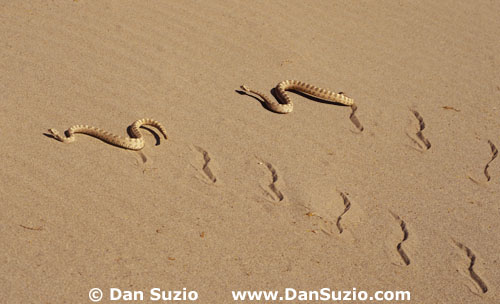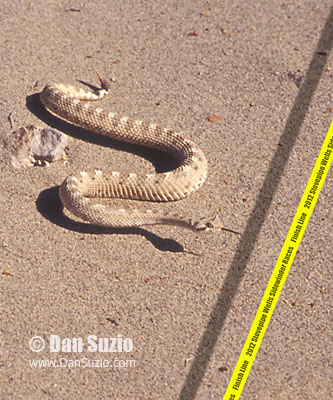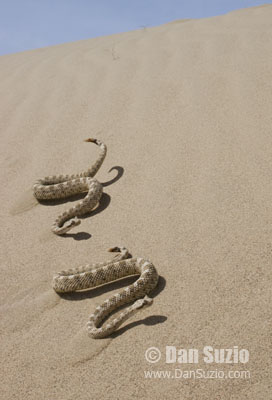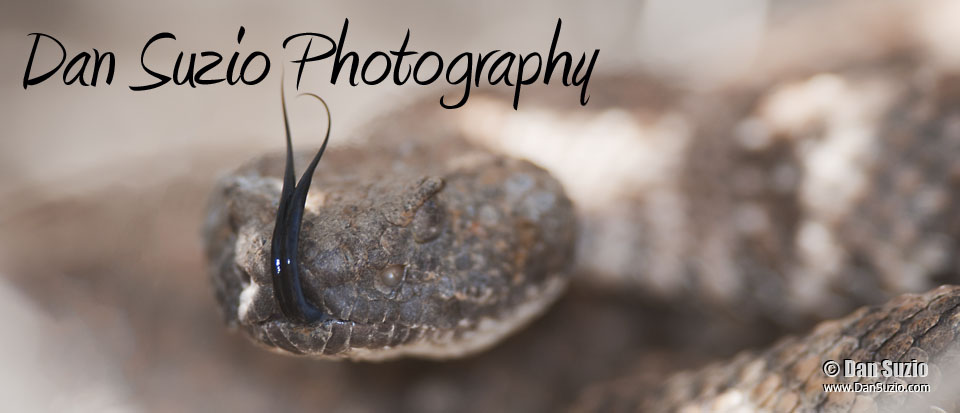Tuesday, April 2, 2013
Sidewinder races? Really?
I hope you enjoyed my April Fool's Day story! (Some of you may remember it from last year.) It sounds like a few people fell for it, others were amused by it, and some wanted to know how much "truth" the story contained. So, just for the record ...
Panamint Springs Resort, the Death Valley Natural History Association, Furnace Creek Resort, and the Timbisha Shoshone Tribe are all real organizations. I hope they don't object to my using their names. Bakersfield is a real place, too, or so I've heard.
All of the historical figures I mentioned are real people. Death Valley Scotty was a well-known con man who I like to imagine would have staged a sidewinder race if he had thought of it. Albert Johnson was a Chicago millionaire who continued to fund Scotty's extravagant lifestyle long after realizing he'd been conned. His vacation home in Grapevine Canyon, which he called Death Valley Ranch, is now known as Scotty's Castle. Shorty Harris and Pete Aguereberry were prospecting partners, until Shorty took credit for Pete's gold discovery and named the resulting town Harrisburg (it's now called Aguereberry Camp). Father John Crowley was a priest whose parish covered 30,000 square miles from Bishop to Barstow. He was well known to Death Valley's prospectors.
PETA (People for the Ethical Treatment of Animals) really does have an anti-fur campaign called "I'd rather go naked." I don't know how often, if ever, their protests have been stopped by a shortage of sunscreen.
The Yosemite Firefall was a real event. Each evening during the summer tourist season, employees of the Glacier Point Hotel would build a bonfire and shove the glowing embers over the cliff after dark. By current standards it sounds like a pretty crazy thing to do in a national park - almost as crazy as holding a snake race in Death Valley.
Turtle races, rattlesnake roundups, and other cruel forms of "entertainment" really do exist, and various people have tried to shut them down. I hope they succeed.
I can't be absolutely positive, but I'm pretty confident that the following two sentences are true: "The Mark Twain Archive at the University of California has no record of the invitation," and "If you travel to Death Valley next spring looking for the sidewinder races, you're not likely to find them."
On the other hand, you really can buy a t-shirt or mug as a souvenir of the fictional race.
As for the photos - well, as Paul Simon might say, "Mama, don't take my Photoshop away!"
Monday, April 1, 2013
A day at the races

Excitement was in the air - along with the usual blowing sand - at the annual Stovepipe Wells Sidewinder Races, an event that stands out even in Death Valley, where quirky characters and unlikely occurrences are part of the local history. With a record number of entrants, this year's competition had to be extended to three days, although the party has traditionally lasted somewhat longer. The actual races take place only for about an hour each morning and evening, avoiding the oppressive daytime temperatures and leaving plenty of time for other activities.
Most entrants this year were self-described "desert rats," although each of the park's major concessionaires and partners also sponsored an entry. Panamint Pete, representing Panamint Springs Resort, fared the best of the sponsored entries, edging out Rambo, the entry of the Death Valley Natural History Association, in the semifinals. Shorty Hairless, entered by Furnace Creek Ranch, and Timbisha, representing the Timbisha Shoshone Tribe, each made it to the quarterfinals. Scotty's Ghost, a rare albino sidewinder entered by a reptile collector from Bakersfield, also performed well but lost in the semifinals.
In the end, the coveted Slithering Serpent trophy went to Creosote, the entry of a mysterious character who identified himself only as Gyro. After a quick thank you and a cold beer, he hopped into his pickup and slipped away before he could be interviewed.

Origins clouded
As with much of Death Valley's history, the origins of the race are clouded by legend and exaggeration. Most popular accounts credit Walter Scott, better known as Death Valley Scotty, with organizing the first race. Scotty was inspired (so the story goes) when he read Mark Twain's "The Celebrated Jumping Frog of Calaveras County," and saw the promotional opportunity in staging a similar event in Death Valley. In a letter to Albert Johnson, his long-time benefactor, Scotty claimed to have invited Twain to visit Johnson's Death Valley Ranch and document the race. Whether Scotty was unaware of Twain's death a decade earlier or had simply let his tendency to exaggerate go too far is not clear. The Mark Twain Archive at the University of California has no record of the invitation.
Other historians, while acknowledging Scotty's unparalleled marketing skills and role in promoting the event, cite evidence that the idea for the race originated with Pete Aguereberry, the reclusive Basque miner. It was his one-time partner Shorty Harris, they say, who first promoted Pete's idea while claiming it as his own.
Most accounts agree that the legendary "Desert Padre," Father John Crowley, officiated at that first race, presumably because he was the only observer sober enough to accurately judge the winners. Surprisingly, there are no reports of snakebite, fatal or otherwise, resulting from the race.
The race was resurrected sometime in the 1960s or 70s - again, no one is really sure - and occurred sporadically over the next couple decades, becoming an annual event around 1996. In the past few years, what began as an informal gathering of desert rats and amateur herpetologists has blossomed into a major celebration.

The last race?
Not everyone, however, is celebrating. In 2007 a small group of animal rights activists, inspired by PETA's "I'd rather go naked" anti-fur campaign, attempted to disrupt the race while wearing only sandals and carrying a 30-foot-long inflatable snake. They had to abandon their protest due to a shortage of sunscreen.
More recent criticism has centered on the safety aspects of handling venomous snakes, and especially on the appropriateness of holding the race in a national park, where all wildlife is protected by law. While the National Park Service has never officially sanctioned the race, rangers have always looked the other way and allowed it to continue. Critics compare it to the Yosemite Firefall - a summer tradition in which burning embers were tossed off Glacier Point - which was discontinued in 1968 because it conflicted with the mission of the national parks.
Others argue that the race should not exist at all. Animal rights supporters consider it to be cruel and abusive to the snakes, and biologists point out the stress on individual snakes as well as on the natural ecosystem. Most of the snakes are released afterward, but participants don't always return them to the exact locations where they were captured, which can disrupt existing populations.
In recent years, turtle races and rattlesnake roundups in Texas and other states have been the target of environmentalists and animal rights activists. For many years the Stovepipe Wells race escaped such criticism because it was not widely known, but all that has changed now. If you travel to Death Valley next spring looking for the sidewinder races, you're not likely to find them.
Been there, done that, forgot to buy the t-shirt? Get your official Sidewinder Race souvenirs here!
Update: Just in case you didn't notice the date on this post, here's the story behind the story.
Subscribe to:
Posts (Atom)

